PPT-Quick Breads, Cakes, Pastries, Pies, and Cookies
Author : alexa-scheidler | Published Date : 2019-12-19
Quick Breads Cakes Pastries Pies and Cookies Quick Breads Quick Breads such as Biscuits scones and muffins can be prepared faster such as their name suggests Quick
Presentation Embed Code
Download Presentation
Download Presentation The PPT/PDF document "Quick Breads, Cakes, Pastries, Pies, and..." is the property of its rightful owner. Permission is granted to download and print the materials on this website for personal, non-commercial use only, and to display it on your personal computer provided you do not modify the materials and that you retain all copyright notices contained in the materials. By downloading content from our website, you accept the terms of this agreement.
Quick Breads, Cakes, Pastries, Pies, and Cookies: Transcript
Quick Breads Cakes Pastries Pies and Cookies Quick Breads Quick Breads such as Biscuits scones and muffins can be prepared faster such as their name suggests Quick breads use chemical leaveners. Yeast Breads in General. They have a distinctively appealing sweet smell and delicious taste that cannot be matched to commercially prepared sandwich breads.. Many meal managers rely on the ease of bread machines to make homemade bread an option to their menu plans.. No waiting for the dough to rise. Banana Bread. Waffles. Pancakes. Biscuits. Scones. Soda Bread. Ingredients In Quick Breads. Flour-hard and soft wheat flours. Eggs-large whole eggs. Fat- usually shortening or oil. By the end of class you will be able to:. Define what a leavening agent is. Identify the types of leavening agents and their purpose. Describe the steps to make a quick bread. Explain the muffin method. . Chapter 28. Terms to Know. Consistency. Leavening Agent. Gluten. Tenderize. Main Idea. Quick breads are products with a bread- or cake-like texture that DO NOT contain yeast.. They do not require a lot of time or equipment to produce. Pastry, Cake, and Cookie Tools and Techniques. Learning Objectives. Describe the creaming method.. Explain the two-stage mixing method.. Discuss the angel food cake mixing method.. Explain the cold and warm foaming mixing methods.. Objective. Explain how ingredients and preparation procedures affect the quality of quick breads and batters.. Quick Breads and Batters. Chemical . leaveners. . expedite. the leavening process for . Baker. Nature of the Work. Bakers produce . a variety of . bread, pastries, and other baked goods for sale in establishments such as bakeries, grocery stores, and manufacturers' outlets.. In small bakeries or specialty shops, bakers bake small quantities of breads, pastries, cookies, and pies for consumers. Please use workbook p. 113 to take notes during the presentation. Categories of Breads. Quick Breads. Yeast Breads. Prepare in a short amount of time. Biscuits. Muffins. Popovers. Cream puffs. Pancakes. Objectives. Describe. the functions of basic ingredients used in cakes.. Identify. six types of cookies.. Explain. principles of pastry preparation.. Compare. characteristics of crystalline and . If you love to bake, this may be the only book you need�it contains all the best baking recipes in one place!�From warm cinnamon rolls and gooey chocolate chip cookies to classic birthday cakes and fruit-filled pies, there\'s something for every taste and every occasion.For celebrating and feeding a crowd, there\'s nothing better than a cake! Choose from pound cake, layer cake, cheesecake, coffeecake or cupcakes.For after�school snacks, picnics and potlucks, try one of dozens of delicious cookies, brownies or bars.Make your mornings�and every meal�better with homemade bread, including muffins, biscuits, scones, quick breads and yeast breads. And create wonderful memories with a sensational selection of pies and tarts as well as cobblers, crisps and more.More than 90 irresistible recipes, each with a beautiful photo!Hardcover, 192 pages Who can resist bruschetta rubbed with garlic and drizzled with olive oil, almond-studded biscotti dipped in coffee or wine, and, of course, a thin-crusted pizza with fresh, sweet tomatoes and tangy mozzarella? These Italian classics that Americans know and love are just the beginning there are a wealth of other equally delicious breads and sweets waiting to be discovered. � In this groundbreaking classic�now thoroughly updated for today�s modern kitchen�Carol Field introduces artisanal doughs and techniques used by generations of Italian bakers. Every city and hill town has its own unique baking traditions, and Field spent more than two years traversing Italy to capture the regional and local specialties, adapting them through rigorous testing in her own kitchen. � Field�s authentic recipes are a revelation for anyone seeking the true Italian experience. Here�s a chance to make golden Altamura bread from Puglia, chewy porous loaves from Como, rosemary bread sprinkled with coarse sea salt, dark ryes from the north, simple breads studded with toasted walnuts, succulent fig bread, and Sicilian loaves topped with sesame seeds.�The Italian Baker is the only comprehensive book, in English or Italian, to cover the entire range of Italian baking, from breadsticks and cornetti to focaccia, tarts, cakes, and pastries. There is even a chapter on using leftover bread�with recipes ranging from hearty Tuscan bread soup to a cinnamon and lemon-scented bread pudding. � Winner of the International Association of Culinary Professionals Award for best baking book, The Italian Baker was also named to the James Beard Baker�s Dozen list of thirteen indispensable baking books of all time. It has inspired countless professionals and home cooks alike. This latest edition, updated for a new generation of home bakers, has added four-color photography throughout, plus new recipes, ingredients and equipment sections, source guides, and weights. One of the most revered baking books of all time, The Italian Baker is a landmark work that continues to be a must for every serious baker. Who can resist bruschetta rubbed with garlic and drizzled with olive oil, almond-studded biscotti dipped in coffee or wine, and, of course, a thin-crusted pizza with fresh, sweet tomatoes and tangy mozzarella? These Italian classics that Americans know and love are just the beginning there are a wealth of other equally delicious breads and sweets waiting to be discovered. � In this groundbreaking classic�now thoroughly updated for today�s modern kitchen�Carol Field introduces artisanal doughs and techniques used by generations of Italian bakers. Every city and hill town has its own unique baking traditions, and Field spent more than two years traversing Italy to capture the regional and local specialties, adapting them through rigorous testing in her own kitchen. � Field�s authentic recipes are a revelation for anyone seeking the true Italian experience. Here�s a chance to make golden Altamura bread from Puglia, chewy porous loaves from Como, rosemary bread sprinkled with coarse sea salt, dark ryes from the north, simple breads studded with toasted walnuts, succulent fig bread, and Sicilian loaves topped with sesame seeds.�The Italian Baker is the only comprehensive book, in English or Italian, to cover the entire range of Italian baking, from breadsticks and cornetti to focaccia, tarts, cakes, and pastries. There is even a chapter on using leftover bread�with recipes ranging from hearty Tuscan bread soup to a cinnamon and lemon-scented bread pudding. � Winner of the International Association of Culinary Professionals Award for best baking book, The Italian Baker was also named to the James Beard Baker�s Dozen list of thirteen indispensable baking books of all time. It has inspired countless professionals and home cooks alike. This latest edition, updated for a new generation of home bakers, has added four-color photography throughout, plus new recipes, ingredients and equipment sections, source guides, and weights. One of the most revered baking books of all time, The Italian Baker is a landmark work that continues to be a must for every serious baker. From beginning home baker to artisanal bread makerBaking a perfect loaf of bread is part science and part magic. Created from four simple ingredients of flour, yeast, water, and salt, breadmaking is one of the most difficult (and delicious) baking endeavors. Bread Baking for Beginners is a rare bread cookbook for true beginners to keep their bread baking on the rise.Complete with step-by-step photographs and straightforward instructions, this beautiful bread cookbook offers a tasty collection of recipes for kneaded, no-knead, and enriched breads. In addition to important info on everything from prep and proof times to key terminology and kitchen essentials, this definitive bread cookbook covers you beyond the pan, addressing the perils of an unsuccessful bake.From total scratch to your very first batch, this bread cookbook includes:Knead to know?Discover the science behind the bread making process, popular techniques, and the tools needed to bake a fluffy, flavorful loaf.Stepping scones?Progress from a beginner�s, easy-to-master recipe into dozens of sweet and savory breads.From �doh� to dough?Troubleshoot bread-specific issues with FAQs that address everything from burnt brioche to deflated baguettes.Bread Baking for Beginners helps make artisan bread effortless, so you can share homemade loaves with the people you love. A sweet and savory collection of more than 100 foolproof recipes from the reigning Queen of Baking Mary Berry, who has made her way into American homes through ABC\'s primetime series, The Great Holiday Baking Show, and the PBS series, The Great British Baking Show.Baking with Mary Berry draws on Mary\'s more than 60 years in the kitchen, with tips and step-by-step instructions for bakers just starting out and full-color photographs of finished dishes throughout. The recipes follow Mary\'s prescription for dishes that are no fuss, practical, and foolproof-from breakfast goods to cookies, cakes, pastries, and pies, to special occasion desserts such as cheesecake and souffl�s, to British favorites that will inspire.Whether you\'re tempted by Mary\'s Heavenly Chocolate Cake and Best-Ever Brownies, intrigued by her Mincemeat and Almond Tart or Magic Lemon Pudding, or inspired by her Rich Fruit Christmas Cake and Ultimate Chocolate Roulade, the straightforward yet special recipes in Baking with Mary Berry will prove, as one reviewer has said of her recipes, if you can read, you can cook.
Download Document
Here is the link to download the presentation.
"Quick Breads, Cakes, Pastries, Pies, and Cookies"The content belongs to its owner. You may download and print it for personal use, without modification, and keep all copyright notices. By downloading, you agree to these terms.
Related Documents

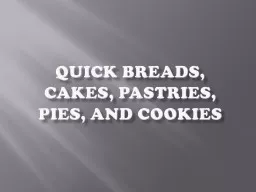
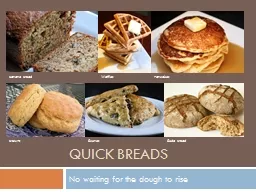

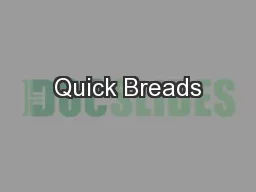
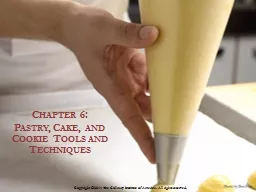

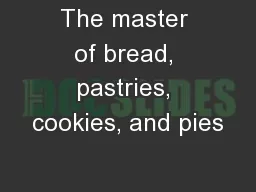

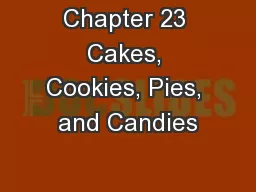
![[EBOOK] - Baking: Essential Recipes for the Best Cookies, Cakes, Pies & Breads](https://thumbs.docslides.com/887183/ebook-baking-essential-recipes-for-the-best-cookies-cakes-pies-breads.jpg)
![[EPUB] - The Italian Baker, Revised: The Classic Tastes of the Italian Countryside--Its](https://thumbs.docslides.com/888302/epub-the-italian-baker-revised-the-classic-tastes-of-the-italian-countryside-its-breads-pizza-focaccia-cakes-pastries-a.jpg)
![[EPUB] - The Italian Baker, Revised: The Classic Tastes of the Italian Countryside--Its](https://thumbs.docslides.com/890185/epub-the-italian-baker-revised-the-classic-tastes-of-the-italian-countryside-its-breads-pizza-focaccia-cakes-pastries-a-61543e4721b9c.jpg)
![[READ] - Bread Baking for Beginners: The Essential Guide to Baking Kneaded Breads, No-Knead](https://thumbs.docslides.com/890483/read-bread-baking-for-beginners-the-essential-guide-to-baking-kneaded-breads-no-knead-breads-and-enriched-breads.jpg)
![[DOWNLOAD] - Baking with Mary Berry: Cakes, Cookies, Pies, and Pastries from the British](https://thumbs.docslides.com/890561/download-baking-with-mary-berry-cakes-cookies-pies-and-pastries-from-the-british-queen-of-baking.jpg)